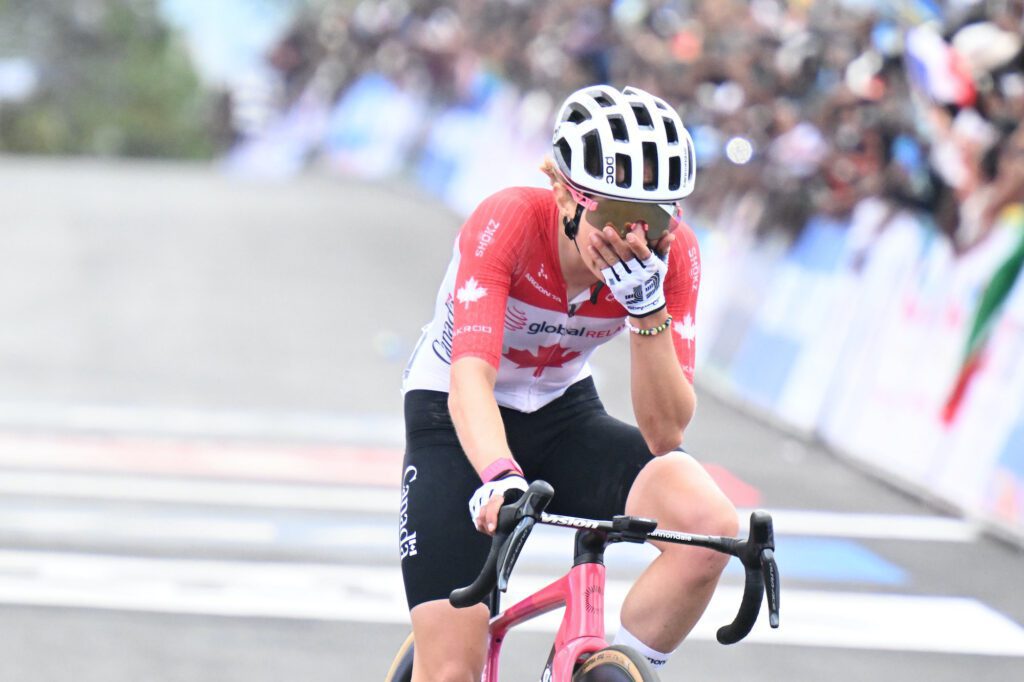Magdeleine Vallières became the first Canadian in history to win the UCI world road race Championship — but she had to pay her own way to get there. She flew from Girona to Rwanda and spent several days in Kigali before taking the victory that made history. Many other Canadian national team riders, across juniors, under-23, and elite levels, faced a similar situation.
For athletes travelling from Canada, the cost could be significant — flights often run several thousand dollars, on top of project fees designed to support athletes once they arrive. In Europe, travel and costs are generally lower. But should Vallières have been paying anything at all? To explain, Canadian Cycling Magazine spoke with Scott Kelly, Cycling Canada’s chief sport officer, about the funding reality and plans to grow opportunities for athletes.
The three-tier system
Kelly outlined the “three-tier” structure, which was tightened a few years ago. “Podium athletes do not pay a project fee and have their flight covered,” he said. “Core and Affiliate athletes pay a project fee and cover their own flight. So yes, if she had already been classified as podium pool at the time, she wouldn’t have been charged a project fee.”
He added that standardizing project fees helps insulate teams from the varying costs of hosting the worlds — whether in Belgium, France, Switzerland, or Rwanda — and gives athletes a clear budget to plan around. “It’s not perfect, but it’s a fairer way of managing costs and keeping opportunities open,” Kelly said. With some pro athletes–their trade teams themselves help with costs, as well.
Funding realities
Cycling Canada’s funding has not grown at the same pace as the costs of running national team projects across multiple disciplines. There was a time when athletes, whether junior, under-23 or elite, did not have to worry about any fees. Of any sort. Those days are over.
“The ‘free’ projects of the 80s and 90s were being subsidized at a level that isn’t sustainable now without cutting opportunities,” Kelly said. The current structure aims to support podium-potential athletes while keeping development pathways open.
Project fees have fallen significantly in recent years, however, he said. Between 2015 and 2020, Cycling Canada collected an average of $400,000 annually in project fees; from 2023 to 2025, the average dropped to $265,000. In Rwanda this year, the lowest project fee was about $400, the highest $1,600 for a 16-day stay, and the average around $760. Fees cover accommodation, meals, mechanical, medical, and therapy support.
Government carding also helps with travel and training, but many juniors and under-23 riders still rely on parents or fundraising unless already on a Senior or Development card. Which, Kelly agreed, in the era of expensive bikes and kit — if not sponsored — is another additional ask of parents.
Legacy programs like the 2003 Cycling Foundation provided nine juniors with $2,500 each for their Worlds trip. That is the program created after Hamilton covered the 2003 road worlds.
Supporting the next generation
Donor programs such as Club 1882 aim to offset costs for up-and-coming riders. “It’s not a magic wand, but we’ve reduced total yearly project fees over the past couple of seasons,” Kelly said. The program has grown rapidly, raising an average of $285,000 annually since 2020 — up from $36,000 per year before — and totaling $1.7 million since launch.
“With government funding flat and the Canadian dollar weak, we’re doing the best we can with what we have,” Kelly said. “There’s a real opportunity for the community to rally around Cycling Canada and the National Team. Programs like 1882 let people contribute directly to the next generation, and anyone interested can play a part.”
Either way, the good news is — Vallières is definitively not paying her way to Montreal 2026. She is now in the podium tier, because, well, the 23-year-old reached the top tier in Kigali. What. A. Race.

